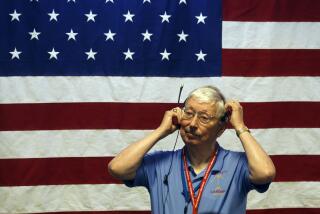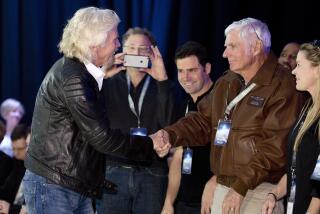James Martin Jr., 81; Oversaw 2 Missions to Mars
James Martin Jr., a NASA engineer who in the 1970s was project manager of the unmanned space missions to Mars known as Viking 1 and 2, the first U.S. expeditions to land safely on another planet, has died. He was 81.
Martin died April 14 of cancer at a son’s home in Crofton, Md.
Martin, an aerospace engineer, joined NASA’s Langley Research Center in 1964 as assistant project manager for the Lunar Orbiter Project. The orbiters’ five subsequent missions brought back essential information about the moon later useful in the manned Apollo flights.
For his role in Lunar Orbiter, he received NASA’s Exceptional Service Medal in 1967. But a bigger-profile role was yet to come, on the intricate nationwide, $1-billion effort known as Viking. Its goals were to check for signs of life on the red planet and conduct other studies for manned missions there.
Martin became project manager in the late 1960s, and it was a daunting endeavor. One scientist at the time likened the precision involved to tossing a basketball from an arena in Los Angeles and getting it through the hoop at Madison Square Garden in New York.
He spent much of his time on charting cost and logistical projections for the Viking expeditions, robot-controlled spacecraft timed to land around the nation’s bicentennial in July 1976.
Over the years, he oversaw 750 scientists and technicians coordinating a trip of more than 500 million miles. He used data from the Mariner orbiters already circling Mars to select safe landing spots for Viking on what appeared to be a knotty surface.
Martin was known for his austere and sensible manner, often canceling contracts with contractors when they failed to make deadlines. He said sloppiness would cost NASA, and taxpayers, hundreds of millions of dollars.
Problems did arise. Technical mishaps wound up delaying both launches by several days.
Two identical Viking rockets went up from Cape Canaveral, Fla., on Aug. 20 and Sept. 9, 1975. After changes in the original landing plans based on new information, Viking 1 made it to Mars on July 20, 1976, and Viking II on Sept. 3 of that year.
The thousands of color images sent back by the Viking spacecraft revealed tantalizing pictures of Mars as a flat, rock-covered plain with long, narrow clouds floating in a reddish sky. Soil and atmospheric analyses also were conducted.
Though designed to last only 90 days, both Viking landers continued to transmit information back to Earth into the early 1980s.
Martin resigned from NASA at the end of 1976 to become vice president of advanced programs and planning for Martin Marietta Aerospace in Bethesda, Md. He retired in 1983.
He continued working as a NASA consultant, with projects such as the Mars Pathfinder mission of the mid-1990s. That was the only other U.S. project to land successfully on Mars.
In recent years, he was asked back to help restructure the Mars exploration program after expensive mishaps with the Climate Orbiter and Polar Lander.
He played a role in the Mars Odyssey mission, which was launched in 2001 and continues to send back data about Mars while it orbits the planet.
James Slattin Martin Jr. was born in Washington, D.C., but grew up in Springfield, Ill. He liked building model airplanes, and by his early teens was designing gas-powered craft. Sometimes he tried too hard, as when he overloaded two planes with fuel and then launched them.
“My father and I tried to follow them in the car, but never did find them,” he said in his official NASA biography.
He was a 1942 aeronautical engineering graduate of the University of Michigan; during summers he worked on an assembly line.
He credited that experience with teaching him how to balance his interest in design with what would work.
From 1942 to 1964, he worked for Republic Aviation Corp. in New York. During World War II, he worked on design for the P-47 Thunderbolt fighter and the F-84, a pioneering fighter jet. He left Republic as manager of space systems requirements.
Survivors include his wife, Frieda Rexroth Martin; two children from his first marriage; two children from his second marriage; a sister; nine grandchildren; and two great-grandchildren.
More to Read
Sign up for Essential California
The most important California stories and recommendations in your inbox every morning.
You may occasionally receive promotional content from the Los Angeles Times.










